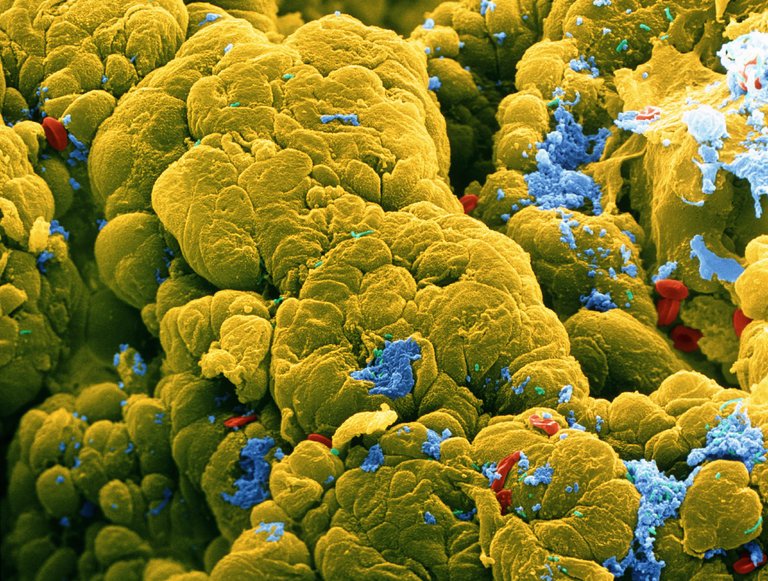Can gut microbes cause cancer?
Our gut contains many microorganisms. On average the weight of the gut microbiome is about 2 kg. That’s 2 kilograms of other species we are carrying with us at all times! To reach this weight there have to be many microbes. Our gut contains tens of trillions of microbes, of which there are at least 400 different species present. Some sources say even say there are at least 1000 different species.1-2 Of these different species we share about a third with everyone else, while the rest is unique to us. It’s a gut fingerprint!

Figure 1. Electron micrograph. Yellow is cancerous colon tissue, red is blood cells, blue is mucus, and bacteria are light green. Dejea et al. 2018
The vast majority of these microorganisms are concentrated in the large intestine (Figure 2). The stomach is primarily for primary breakdown due to physical, chemical, and enzymatic effects. The small intestine further breaks down ingested food and is the location where most of the nutrient absorption happens. Whatever is left goes to the large intestine where the gut microbiome consumes any leftover nutrients and deals with the rest-products.
Figure 2. The concentration of microflora in different parts of the gastrointestinal tract. Note that the Y-axis is on a log scale! Medical Microbiology. 4th edition
The good, the bad, and the ugly.
Most of these microorganisms are good for us. Wouldn’t it be something if they are just freeloading off of us without doing anything? General benefits they provide are as follows:
- They neutralize toxic byproducts of the digestive process.
- They protect against invasive yeast and bacterial species that can harm our body.
- They reduce toxins and carcinogens.
- They produce the vitamin B and K.
- They keep the gut cells healthy and make sure they grow properly.
- They help by improving absorption of nutrients.
This is a whole set of beneficial effects. Sadly, there are also a variety of diseases and harmful effects that can be caused by both naturally present and invasive species.
Bacterial diarrheas are the most commonly observed effect. Enterotoxins, which are toxins affecting the large intestine, are produced by multiple bacteria. When these bacteria take hold the toxins initial effect is fluid loss. The bacteria take their residence in the upper small intestine and produce a more watery discharge, worsening diarrhea. The prime example is drinking water contaminated with cholera. Cholera can cause stool volumes of 1 L/h. It is vital to stay hydrated since the total daily amount can reach up to 20 L. That’s a lot of water you need to drink! Another example is Escherichia coli, which is also known as the traveler’s diarrhea.
At least the enterotoxin-producing bacteria don’t damage the epithelial cells of the mucus layer between the internal intestine and intestine wall. Because that’s exactly what the invasive pathogens _Salmonella, Shigella, Campylobacter, invasive Eschericia Coli, and Yersinia. Some viruses can go through the same process, invading and damaging the mucus layer. The damage caused by viruses is at least not as bad as the invasive bacteria. Let’s look at the bacteria causing the most problems. Salmonella finds residence in the lower ileum and damages the mucus layer. After a while it enters the lymphatic system and the bloodstream, causing a host of infections. Of course, diarrhea is also there because it causes secretion of fluids into the intestines. Shigella causes Dysentery, which is a disease of the lower intestine. The bacteria cause ulceration of the mucus layer. An ulcer is the sore that is formed on the mucous membrane. It causes heavy damage and can result in complete breakdown of the local mucus layer.3
The rotavirus and Calicivirus, also known as Norwalk virus, also cause diarrhea. The rotaviruses are infamous for their effect on infants in the third world, as they are often fatal.
Now for the worst, the ugly. Researchers found that colon cancer could actually be caused by two bacteria.4 Worse is that these two bacteria are commonly found in our gut. The bacteria increasing cancer risk are a strain of Escherichia Coli and Bacteroides fragilis. Let’s first answer the question how these bacteria increase the risk for colon cancer.
As mentioned before, there exists a layer of cells, which is called the mucus, that protects the wall of the intestine and the rest of the body from the contents of the intestine. The researchers found that aforementioned bacteria can go through this layer, where they cover the intestinal inner wall with a thin film of their cells. As they are growing in this film structure they produce toxins that damage the DNA of colon cells and cause inflammation. The synergy of these bacteria is especially effective at causing damage to the DNA of the colon cells.
With approximately 50.000 dying every year of colon cancer, it is great that more causes are identified. The researchers are confident that these bacteria are one of the primary factors of concern regarding colon cancer. Therefore people who are found to have these bacteria in their gut should visit their doctor more often to check up on their microbiome.
Stay healthy folks!
References:
Recently from @Altherion
Paper discussion #4 – The Cloning Revolution
Supplements #1: Echinacea
Paper discussion #3 - A prevention for cancer?
The Farmer's Friend
Urban Farming
by FoodLabScience
Twitter

A scientist’s food for thought!

Being A SteemStem Member
As a follower of @followforupvotes this post has been randomly selected and upvoted! Enjoy your upvote and have a great day!